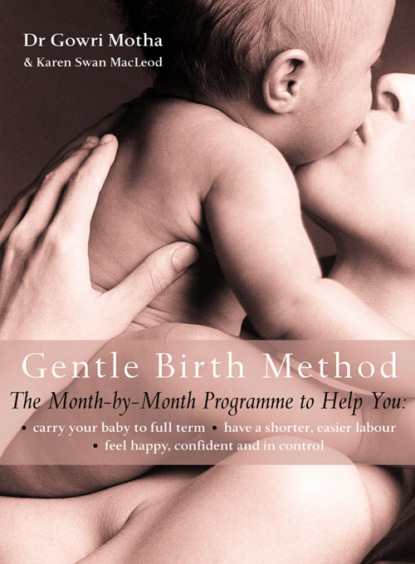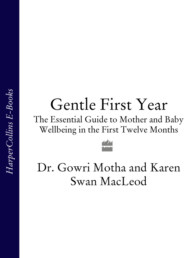По всем вопросам обращайтесь на: info@litportal.ru
(©) 2003-2024.
✖
The Gentle Birth Method: The Month-by-Month Jeyarani Way Programme
Автор
Год написания книги
2018
Настройки чтения
Размер шрифта
Высота строк
Поля
Digestive sluggishness
Passive
Calm, steady
Lethargic
Slow to be irritated
Heavy sleeper
Kapha in balance: strong and calm
Kapha out of balance: dull and lethargic
During pregnancy
Can experience aches and pains in the joints and spine.
May experience breathlessness.
Prone to gestational diabetes – even the baby can develop diabetic tendencies.
Indigestion is common.
How to Counteract Kapha
Exercise
All forms of exercise benefit the kapha mother. Aerobic activity such as walking and swimming are ideal for boosting oxygen supply to the body and to the baby, and for supporting the heart, which is under more pressure during pregnancy. But keep an eye on your pulse and make sure your heart is working at no more than 120 beats per minute. Yoga and stretching build strength in the muscles, encouraging them to protect the mother’s skeletal structure. But avoid all twisting exercises and do not use your abdominal muscles at all, as they will have separated to allow room for the baby. Pilates classes should be avoided for this reason, but are excellent for post-natal recovery.
Food
Do not eat anything white or pasty – so avoid toast, bread, rice pudding and all puddings.
Avoid pasta, cakes, sweets, crisps and ice creams.
Avoid beef, pork and lamb. Chicken is allowed – two small portions per week.
Choose spicy foods.
Eat lots of green vegetables and light clear soups.
Fruits to enjoy: apples, apricots, cranberries, pears.
Vegetables good for kapha include: asparagus, celery, leafy greens, spinach, turnips, coriander, parsley.
Kapha-predominant mothers can also eat chicken, eggs, fish, goat’s milk.
Eat pumpkin seeds, sunflower seeds, flax seeds.
Don’t over-cook grains; eat when just done.
Treatments
Warm baths are very beneficial. To make the bath more therapeutic you can add a few drops of essential oil of basil as this activates your endorphins and improves your mood.
Other essential oils that can reduce kapha and lift your mood are eucalyptus, camphor, neroli, tea-tree, juniper and fennel. Use in massage oils, or add a few drops to your bath.
In Sri Lanka and India, it is common to add medicinal leaves called Nirgundi to your bath. The botanical name of Nirgundi is Vitex Nirgundi. In ancient Ayurvedic texts this is prescribed to reduce kapha. It is best to use fresh crushed leaves. Alternatively a tincture can be obtained (see Appendix C, page 312).
Have regular lymphatic drainage massages (Creative Healing massage is very efficient for lymphatic drainage).
Alternatively, a simple self-massage can be given with dry finely powdered mung beans. The powder acts as a fine abrasive and as an astringent to draw out excess body fluids. A pinch of medicinal turmeric can be added to the mung bean powder. Triphala powder can also be used in powder massage; this is a powder made up of three fruits that suit all doshas. (Mung bean powder can be made yourself by crushing them in a coffee grinder to a fine consistency. Medicinal turmeric and Triphala powder can be obtained from any Ayurvedic supplier – see Appendix C, page 312).
Warm oil massage can be incorporated with powder massages. Triphala oil is available and this can be mixed with sesame oil and used for massage. This can be done as a simple self-massage all over the body with circular strokes, or it can be performed by an Ayurvedic technician. The Triphala oil and sesame oil can be obtained from any Ayurvedic supplier.
Reflexology is very good for reducing kapha. Focus on the lymphatic drainage reflex areas on the feet to make sure that the lymph drainage channels are kept clear. I recommend at least ten reflexology treatments from 20 weeks of pregnancy to term.
Kapha Labour Issues
Kapha mothers usually experience uncomplicated deliveries.
If kapha is not controlled during pregnancy the pregnant mother gets the classic ‘bloated’ look. Excess kapha means that the progress of labour can be sluggish with longer labours. Moreover, the baby can get stuck (due to congestion and oedema in the cervix and the pelvic tissues) and the mother may need a Caesarean.
Kapha mothers are prone to going past their due dates, if their excess kapha is not remedied in pregnancy.
Gentle Birth Method Recipes
Over the years, I have had many mothers come to me worried about what to eat and what not to eat. I fully appreciate that it can be daunting to work from both my own dietary guidelines and the Ayurvedic recommendations for each dosha, so I have slowly accumulated a roster of appropriate tasty recipes. A selection of these recipes, which are suitable for all doshas, can be found in Appendix A (see page 277).
Birth Story: The second-time mother – Annabel
I was thrilled to discover I was pregnant with my second child, but once the elation subsided, I felt a deep sense of dread and fear. Would the birth be as traumatic as last time? Would I have to go through induction, stitches, infection and post-natal depression again? As the months went by, I became increasingly anxious. A friend gave me an article about Dr Motha and despite being very sceptical about anything that might be considered ‘alternative’, I decided to go and see her.
I had very little idea of what to expect and was startled by Gowri’s positivity. One of the first things she did was take a full history and actually listen to me explaining my first birth experience. It was a huge relief just to have someone calmly listen, let me talk and not try to explain away or belittle what I had felt. After that, Gowri’s approach was to assure me with absolute confidence that my experience need not be repeated.
I saw Gowri about five times before the birth and felt much more physically and mentally prepared than I had previously. One of my biggest concerns was that I would again need to be induced and suffer bad tearing.
I was two weeks late and there didn’t seem to be much sign of an arrival, so my husband and I decided to go for a long walk. We trudged for hours up and down hills and even though nothing happened, just being outside in the fresh air seemed to help my mood. When I got home I had a hot bath and as I got out, my waters broke. I was really excited and pleased – already I had managed naturally part of the birth experience, which I had begun to think was not going to be possible for me.
A few hours later I was still in a state of high excitement but there were no contractions. We went to the hospital and saw the midwife, who said I could go for another 24 hours before they would want to induce. She recommended another walk. The time, it was in the freezing February rain, and was unpleasant. We got home and I began to think induction was inevitable, when at about 4pm, my contractions started. I felt a huge rush of excitement and fear.
After about an hour, I put on the TENS machine and the contractions started coming closer and closer together, with increasing power. I spent a lot of my time on all fours, crawling about or leaning against the walls. I phoned the hospital at about 6pm and was told to delay coming in for another couple of hours, or until I was unable to walk.
Suddenly, the contractions began to feel very painful indeed and I had the first sense of an urge to push. We got in the car and drove to the hospital. By the time we got there, I was crawling on all fours. The midwives examined me and I was 7cm dilated. I asked to get into the birthing pool and felt an immediate sense of relief at being in the warm water. It felt comforting and made my body seem supported. I used gas and air as well, and this also helped me to relax. At this point, the pain was terrible and I felt overwhelmed. I was desperate to push even though it had only been a few minutes since my last examination. However, when the midwives checked me again, I had gone to full dilatation.
Within a few minutes, the baby’s head had crowned and the contractions had become more regular and less frightening. The midwives told me when to push and within the next few pushes the head emerged, followed quickly by the rest of my daughter’s body. I got out of the pool and was immediately handed the baby, and the placenta was delivered. I was checked and, to my amazement, told I had no need for any stitches. All my greatest hopes for the birth had been fulfilled. I had a beautiful baby girl that I had pushed out without assistance in the water, and I had not torn.






